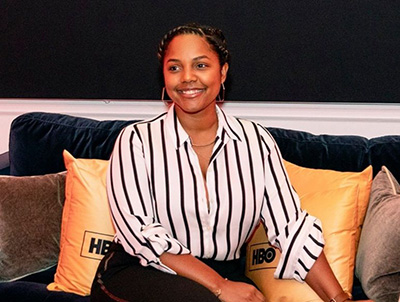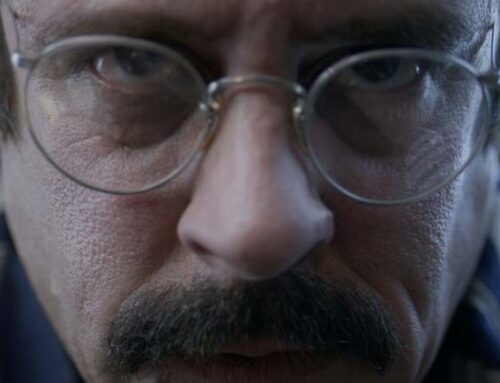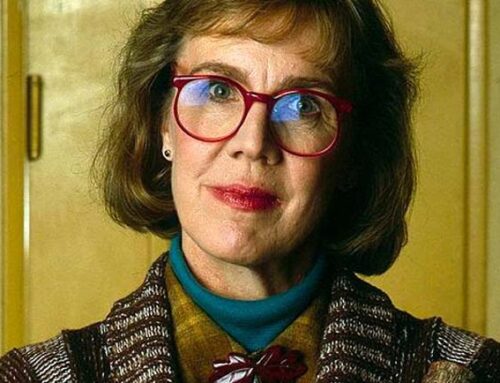In a fascinating conversation, author Alix Kingray sits down with award-winning editors Daysha Broadway, ACE, and Jon Higgins, ACE, to discuss their dynamic work on Your Monster, a film that artfully combines romantic comedy with horror. The duo shares insights on balancing these seemingly disparate genres, crediting the film’s tonal shifts to the performances, Caroline Lindy’s focused direction, and their meticulous editing strategies. Broadway and Higgins delve into the challenges of genre-blending, how they crafted impactful scenes, and the inspiration they drew from both classic rom-coms and iconic horror films, offering a behind-the-scenes look at how Your Monster defies categorization to deliver a fresh, exhilarating cinematic experience.
Hi Daysha and Jon! Your Monster maintains an intriguing blend of rom-com and horror elements. How did you each work to balance those different genres in the edit?

Daysha Broadway, ACE
Daysha Broadway, ACE: It was a fun challenge! The performances and direction were the cornerstone of building the tonal shifts in the film. The actors knew where they were and how to play for the genre of that scene. The film is unique in that, as the scenes progress, the tone changes until it culminates in horror. I think that’s a big testament to Caroline’s skill as a director. She never lost the vision or got lost in the shifts and so neither did her team. When in post, then, it was about crafting around those performances and using pacing, sound, shot selection, and music to shift the tones when we wanted. I will say we had to try to objectively watch the film more times than I could count to make sure we hadn’t leaned too far away from that balance.

Jon Higgins, ACE
Jon Higgins, ACE: The genre blending is what first attracted me to this film. It’s unique and interesting, but balancing that tone on an editing timeline is quite a journey. In early discussions with writer/director Caroline Lindy, she talked about her love of rom-coms and specifically how Nora Ephron inspires her work. While this film takes that genre and turns it on its head, you can’t do that without authentically setting it up as such. So rom-com was always our north star. There were more horror scenes, musical numbers, and even more romantic scenes between Laura and her jerk of an ex, Jacob, that didn’t make it into the final cut because they pulled us too far outside the sandbox, so to speak. But staying true to the POV of Laura and Monster, and their relationship, allowed us to spread our wings outward from there. And yes, I recognize that I’m mixing metaphors to make the point.
The film also stars a rising “scream queen” in Melissa Barrera. What kind of inspiration did her performance offer you while editing the film?
DB: Melissa exceeded my expectations with her masterclass performance. She did everything and her range was inspiring. There were subtle things she gave the performance that were just as impactful as the big musical numbers. She’s inspiring and I hope she gets to do more stuff like this now that she’s played for every genre in one film. Our whole cast was great. Did you see the look on Meghann Fahy’s face when Jacob drags her on stage? Give that one look an Oscar.
JH: Melissa is incredible. Having been in movies like Scream and In The Heights, she brings that experience to the horror and musical elements of this film. But it’s the comedy that is going to feel new and exciting to audiences. She has such great romantic and comedic chemistry with Tommy Dewey (as Monster), and really goes there at times that it’s actually Monster who’s often playing more of the straight man.
What was the biggest challenge you faced while editing this film?
DB: Figuring out how to start the film. I remember Caroline, Kayla Foster, and I sitting in my office in my apartment just staring at the ground in silence after trying our 5th opening of the film. The opening we had was good but was missing the mark somehow. But that collaboration between us and then just giving it a moment to think it through paid off because in that silence, that image of Laura sitting in the wheelchair waiting to be taken home popped in my head and I snapped my head up and pitched it. It was great to have the space to throw around ideas. Whatever makes the film the best it can be was the goal.
JH: Melissa Barrera and Tommy have such great chemistry that once you get to them on screen together, you understand what is so different and special about this movie. However, in the assembly, Monster didn’t enter the film until after minute 33 so getting Monster into the film as soon as possible was a big goal. But there was so much that you needed to learn about Laura and her world to have Monster make any sense in it, so you couldn’t just cut 10 scenes out. A lot of that condensing was done by taking scenes and montaging them, using only the most important dialogue or visual information to tell the story in the most efficient way. And then also using pieces as flashbacks and revealing that information after Monster was already in the movie.
The film also has a surprising amount of gore. How did you approach the tonal balance of the film’s more graphic sequences?
DB: I do think the absence of something in a film makes it that more impactful when you finally do drop it on the audience. You can do it with sound, music, or in our case – the gore. The balance came in making sure we didn’t cut back too much on Monster’s…well…monster. I fought very hard to keep a shot of him eating a glass bottle in the film because of that very thing. Breadcrumbs throughout that film that remind you this is not a human being and he’s got a mean growl and he’s unhinged so when he does snap, you believe it.
JH: Your Monster is not a traditional horror film by any means, so a little goes a long way. Without giving too much away, other than seeing some blood on clothing, there’s really only a few seconds of ‘that’ shot. But it feels like a lot because it’s so impactful and illustrates the other end of the spectrum in terms of where our protagonist starts off in the film.
Can you describe any films or filmmakers that may have served as inspiration for you while working on Your Monster?
DB: I watched a few of my favorite rom-coms. Caroline made me watch that Diane Keaton crying scene in Something’s Gotta Give, but big inspiration came from Guillermo del Toro and his romanticized monsters and the film Practical Magic. Practical Magic was really helpful when Caroline and I were discussing a re-cut of the film’s opening sequence. It was important to us that the first 10 minutes of the film gave you a hint of the different tones of the film but didn’t lean too far either way. The opening sequence to Practical Magic does just that, so it was helpful to keep it in mind.
JH: Nora Ephron, for sure, and Rob Reiner for the rom-com aspects of the movie. But the genre blend was hard to find a 1-to-1 comparison, so I looked at films that blended horror-comedy and/or horror-romance like Shaun of the Dead, Edward Scissorhands, and Only Lovers Left Alive.
Considering Your Monster is director Caroline Lindy’s debut feature, was there anything unique about your approach in working with a first-time director?
DB: I worked with a couple of first time directors before Caroline and it’s interesting to see, especially on a smaller budget indie film, how many hats they have to wear sometimes. I like to lead with grace, always, but especially on something like an indie film with a first-time director. Production can be hard, they don’t always get the shots they want because of time, etc. So I agree with what Jon always says, the edit had to be a safe space. It’s the last shot they get at making their film and it should feel like a comfortable place to do so. And as an editor I have to think outside the box and come up with ideas on how to execute sequences that may not be landing like they should.
JH: My approach is the same whether it’s a first-time director or the first time working with a seasoned director, which is to gain their trust. Their film is now in your hands. You need to show them that you can execute their vision, but also present your own creativity in a complimentary way. For example, you could take a scene that they were worried about and surprise them with how well it can work. With trust, the edit room starts to feel like a safe space with the freedom to explore and discuss ideas without judgment, which I think leads to discovery and a better film overall.
Do you each have a personal favorite scene in the film?
DB: I really enjoyed cutting the ending sequence of the film. It was kind of the point where all the genres of the film collide and the rom-com of it all gets completely flipped. I loved jumping ahead in time and intercutting with the recent past that revealed the “truth.” I thought it would be a fun way to get inside Laura’s head while also messing with the audience’s head. There’s lots of kinetic energy and movement and this great camera work. That, along with sound cues like Monster bursting through the door, allowed me to keep the momentum and end it with a bang.
JH: There is a scene we call ‘Monster’s Closet’ that I love. It’s this sort of fantasy realm where Monster lives in the back of Laura’s closet. I was asked to edit it as soon as dailies were processed because there was some concern about the tight location and some of the tone, and how it would read considering how much the scene is doing in terms of setting us up for Act 3. It is a smaller space, and it’s packed with a lot of nostalgic items that Monster has been collecting over the years because of his love for Laura. But I think it all works to the advantage of the scene and its emotion because Laura is withholding something from Monster, and he’s trying to get it out of her, so the tight space calls for tighter shots, which work to draw you in. As she avoids eye contact with Monster and focuses instead on her surroundings, which are basically a shrine to Laura, this tension builds and eventually erupts into her saying the most hurtful thing to Monster, and then we immediately cut the tension with a line about him taking her socks. It worked really well in the theatre as audiences go from gasping to laughing, and then the scene ends with a sort of “wait, what” line that I won’t spoil here. But the scene does so much, and it went from sounding alarm bells to what Caroline would later say was one of her favorite scenes from the movie.
You both have extensive experience editing comedy and drama. After working on a blend of genres with Your Monster, could you see yourself working in more traditional horror moving forward? Are there any franchises or filmmakers with whom you’d love to collaborate?
DB: I’d love to! I really enjoy Jordan Peele’s catalog of horror films. I think Us is still my favorite. Growing up I watched a lot of Kevin Williamson’s films such as Scream and The Faculty which were more YA, so I can lean either way. I want to be a part of great filmmaking no matter the genre.
JH: Oh, definitely! Horror is really fun to edit and especially to sound design. I grew up on John Carpenter and Wes Craven movies. The Thing is one of my favorite films of all time, horror or otherwise, and the editing in the scene where Kurt Russell tests everyone’s blood still gives me chills. I’ll always love the zombie genre, but I’m open to collaborating on anything that scares the heck out of younger people like it did to me when I was growing up. It’s such a thrill for audiences and the filmmakers.







